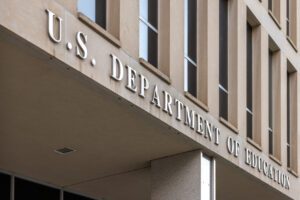A career as a pharmacist can be a lucrative option. But it requires many years of education. According to the U.S. Bureau of Labor Statistics, the typical entry-level education requirement for pharmacists is a doctoral or professional degree. To get the necessary degrees, you’ll likely need to borrow a significant amount of money. In fact, the American Pharmacists Association reported that the average student loan debt for pharmacists sits at $158,000.
Despite the hefty student loan burden, a pharmacy career comes with high earning potential. As of 2024, the median salary was $137,480 per year. A high income could open up more opportunities for refinancing your student loans, especially if you work in the private sector.
Why Refinance Student Loans from Pharmacy School?
If you work as a pharmacist in the private sector — meaning you work for a pharmacy like Walgreens or CVS rather than a non-profit hospital or health organization — you’re ineligible for Public Service Loan Forgiveness, even if you have federal student loans. That makes you a prime candidate for student loan refinancing if you have high-interest student loan debt.
Student loans for graduate and doctoral degrees tend to have the highest interest rates of any education loan. Even Grad PLUS Loans, a form of federal loan, have sky-high interest rates. For loans disbursed after July 1, 2024, and before July 1, 2025, the interest rate is a whopping 9.08%. With such a high rate, your loan balance could quickly balloon.
When you refinance your student loans, you take out a loan from a lender like ELFI for the amount of your combined existing debt. The new loan, which has a different repayment term and interest rate, is used to repay your old loans. Your old loans are then consolidated, giving you just one loan and one easy-to-track monthly payment.
The Benefits of Refinancing Pharmacy School Loans
There are two main benefits to student loan refinancing:
1. You can save money
With a high salary and good credit, you could qualify for a lower interest rate when you refinance your debt, allowing you to save money.
For example, let’s say you had $163,000 in student loan debt at 9.08% interest and a 10-year repayment term. Over the course of your repayment, you’d pay back a total of $248,625; interest charges would add $85,625 to your loan cost.
But let’s say you refinanced your debt and qualified for a 10-year loan at just 6% interest. You’d pay back a total of just $217,156. Refinancing your student loans would allow you to save $31,469.
Try our student loan refinance calculator to find out how much money you can save.
2. You can reduce your monthly payment
If you have a large amount of student loan debt, your monthly payments may be more than you can afford. If that’s the case, student loan refinancing could help make your payments more affordable.
You can choose a longer repayment term when you refinance your debt. You’ll likely pay more in interest over a longer term, but the tradeoff may be worth it to give yourself more breathing room with your cash flow.
Let’s say you had $163,000 in student loan debt with a 10-year repayment term. At 9.08% interest, your minimum monthly payment would be a whopping $2,072 per month. If you didn’t qualify for a lower interest rate, but extended your repayment term to 15 years, you’d reduce your monthly payment to just $1,661 per month, freeing up $411 from your budget.
The Refinancing Process for Pharmacy Grads
To refinance your loans, you can follow these four simple steps:
1. Find out if you meet the eligibility requirements
Each refinancing lender has its own eligibility criteria. At ELFI, borrowers need to meet the following requirements:
- Must be a U.S. citizen or permanent resident
- Must have at least $10,000 in student loans
- Must have a bachelor’s degree or higher
- Must have a minimum income of $35,000
- Must have a credit score of at least 680
- Must have a minimum credit history of 36 months
- Must have received a degree from a Title V U.S.-domiciled non-profit college or university
2. Consider asking a friend or relative to cosign the loan
If you don’t meet the minimum credit or income requirements, consider asking a friend or relative with good credit and reliable income to cosign the loan application with you. A cosigner shares responsibility for your loan, lessening the lender’s risk. Having a cosigner on the application increases your chances of getting approved and qualifying for a lower interest rate than if you applied on your own.
3. Compare repayment options from multiple lenders
While there are many benefits of refinancing student loans, saving money is typically the most important. For this reason, it’s important to compare student loan refinancing interest rates to ensure you’re getting a good deal. ELFI offers competitive rates, flexible terms, and industry-leading customer service for refinancing your student loans.
4. Request a loan estimate
Before submitting a loan application, get an estimate so you know what interest rate and loan term to expect. With ELFI, you can get a rate quote without affecting your credit score so you can select the right loan that works for you.
5. Submit your loan application
Once you find a loan that matches your needs, you can complete the loan application. You’ll be asked to enter information about yourself, including your name, address, Social Security number, employer, income, and current loans.
Other Options for Pharmacists Repaying Student Loans
While student loan refinancing can be a smart idea for pharmacists, it’s not for everyone, especially if you don’t work in the private sector. If you decide against refinancing your student loans, you could get some help with your student loan debt in the form of loan forgiveness, reduced payments, or repayment assistance.
Income-Driven Repayment Plans
If you have federal student loans and can’t afford your payments, you may be eligible for at least one of the three income-driven repayment (IDR) plans. (Note that the SAVE Plan is not currently available.) Under these plans, the federal government extends your loan term to 20 to 25 years and caps your monthly payments at a percentage of your discretionary income. Depending on the repayment plan, your income, and your family size, you could significantly reduce your monthly payment. Some borrowers may even qualify for $0 payments.
Learn More: Recent IDR Plan Challenges & What They Mean for You
Public Service Loan Forgiveness
If you have federal Direct student loans and work for a government agency or non-profit organization, you might qualify for loan forgiveness through Public Service Loan Forgiveness (PSLF). With PSLF, the government will forgive your remaining loan balance if you work for an eligible employer for 10 years and make 120 qualifying payments.
Substance Use Disorder Workforce Loan Repayment Program
The National Health Service Corps (NHSC) operates the Substance Use Disorder Workforce Loan Repayment Program. Under this program, eligible pharmacists can receive up to $75,000 in student loan repayment assistance. In exchange, you have to make a three-year service commitment to work in a substance use disorder site with a health professional shortage area as designated by the NHSC. For more information, visit the NHSC website.
National Institutes of Health Loan Repayment Program
Highly qualified pharmacists willing to commit to biomedical or biobehavioral research careers can receive up to $50,000 in student loan repayment assistance. In return, you must commit to working in a research area in an approved subject. Visit the National Institutes of Health website for more information.



